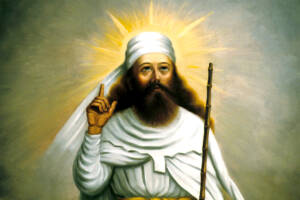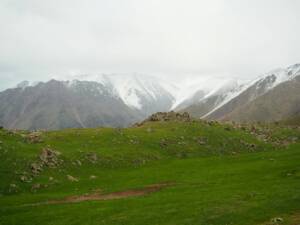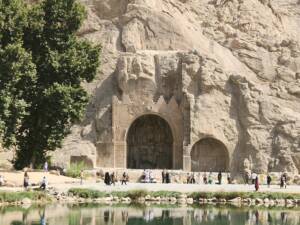Who was Zarathushtra?

Zaraθuštra Spitāma, also known by the name Zoroaster in the west, was an ancient Iranian philosopher, poet, and sage who crafted a spiritual and philosophical way of thinking that would later go on to form the core of the Zoroastrian religion. He likely lived in Central Asia around 1200 BC, where he taught his teachings to all those who desired truth. Besides being the founder of Zoroastrianism, Zarathushtra is primarily known for a series of intricate poems he composed called the Gathas, in which he encoded his teachings and philosophy as a method of instruction for his followers and students.
 Zarathushtra was born in a spacious home on the Dareji river somewhere in the mountains of Central Asia, perhaps around Rāgh, in modern day Badakhshan. He was the son of Pourušaspa, the brash and impulsive, if charismatic leader of the Spitāma clan, and Dughdowa, who as a teen had taken refuge in the town of Spitāmas. While many of the details of Dughdowa’s life are lost to us, what is known is that she was a remarkable and brilliant individual, an attribute which led to her being accused of witchcraft and subsequently being banished from her village. Still, she seemed to impart much of her knowledge and wisdom unto her son Zarathushtra, as the tradition attribute much of Zarathushtra’s miraculous and brilliant nature as coming from his mother.
Zarathushtra was born in a spacious home on the Dareji river somewhere in the mountains of Central Asia, perhaps around Rāgh, in modern day Badakhshan. He was the son of Pourušaspa, the brash and impulsive, if charismatic leader of the Spitāma clan, and Dughdowa, who as a teen had taken refuge in the town of Spitāmas. While many of the details of Dughdowa’s life are lost to us, what is known is that she was a remarkable and brilliant individual, an attribute which led to her being accused of witchcraft and subsequently being banished from her village. Still, she seemed to impart much of her knowledge and wisdom unto her son Zarathushtra, as the tradition attribute much of Zarathushtra’s miraculous and brilliant nature as coming from his mother.
As a child, Zarathushtra was known for being a freethinker and firebrand (a trait he perhaps learned from his mother) who would often argue with the priests his father so faithfully patronized. This frequently got him in trouble with these priests, who tried many unsuccessful ways to quell his independent spirit. This conflict between the priestly establishment and Zarathushtra, which was certainly the result of his antagonism to their beliefs, would set the stage for one of the primary struggles of his life.
 Zarathushtra lived in the society of ancient Iran which was an early Iron age warlike culture occupying a vast network of canals which irrigated the deserts of Central Asia. This society was based on chariot warfare and the nomadic herding of cattle and was divided among a number of fiefdoms ruled by petty kings, or lords, called kavis. These kavis dwelled in small, fortified towns on key points of the irrigation canal and would continually fight with other kavis over land, wealth, and grazing rights. This state of affairs led to a society that was based on continual infighting and raiding at the expense of the common person, a state of affairs which deeply distressed Zarathushtra.
Zarathushtra lived in the society of ancient Iran which was an early Iron age warlike culture occupying a vast network of canals which irrigated the deserts of Central Asia. This society was based on chariot warfare and the nomadic herding of cattle and was divided among a number of fiefdoms ruled by petty kings, or lords, called kavis. These kavis dwelled in small, fortified towns on key points of the irrigation canal and would continually fight with other kavis over land, wealth, and grazing rights. This state of affairs led to a society that was based on continual infighting and raiding at the expense of the common person, a state of affairs which deeply distressed Zarathushtra.
More consequentially, the Kavis sat on top of an institutionalized religious system as both secular and religious leaders, flanked by a class of ritual priests called Karpans. Together, they would conduct rituals centered the ingestion of a psychoactive drug called Haoma (functionally equivalent to Ayahuasca) where the Kavi would “enter” into the spiritual realm and experience strong visions of the gods, which they called Daewas. These Daewas were cruel and capricious, reflecting the warlike, raiding society from which they were born. They were primarily worshiped at these ritual ceremonies where the priests would often perform animal sacrifices, recite intricate poetry in honor of the gods (or manthras), and invoke these gods to aid the kavis in their raiding expeditions.
In short, the Kavis and their Karpans had created a societal structure which perpetuated violence and oppressed the common person. While ancient Iran had its beneficial aspects, it was ultimately backwards and regressive, disposing of wisdom and knowledge for ritual obedience and discarding higher civilization for the personal gain of a small set of priests and rulers. Zarathushtra, seeing this state of affairs, rejected it, realizing that humanity had a much greater potential—that each person could come to their own realization of the divine; that humanity could create a more equal and fair society in which all people, men and women, could benefit. He concluded that these Daewas were the imaginary invention of humans led by wrongful, short-sighted mentalities, and that the worship of them perpetuated the flawed nature of society.
 After coming of age, Zarathushtra left his home and began traveling the world in search of greater wisdom and understanding. He had always been an inquisitive and curious person, eager to understand how things truly worked. Across his travels, he visited many different lands and conversed with many different people, often seeking to help the unfortunate. At some point, he studied at a great institution for the training of Karpans, where he learned the methods of how they composed their intricate manthras, conducted Haoma ceremonies, and tended ritual fires, yet he never once worshiped their false gods. Eventually, he realized there was no great truth in this religious system and left in search of greater wisdom.
After coming of age, Zarathushtra left his home and began traveling the world in search of greater wisdom and understanding. He had always been an inquisitive and curious person, eager to understand how things truly worked. Across his travels, he visited many different lands and conversed with many different people, often seeking to help the unfortunate. At some point, he studied at a great institution for the training of Karpans, where he learned the methods of how they composed their intricate manthras, conducted Haoma ceremonies, and tended ritual fires, yet he never once worshiped their false gods. Eventually, he realized there was no great truth in this religious system and left in search of greater wisdom.
And so he continued to travel, seeking to understand the true meaning of existence and the nature of the divine. Most importantly, he sought to truly understand the laws which governed existence and use this to improve his own mind, reaching a higher state of wisdom and understanding. He called this method of being in an elevated mental state of growth the Good Mind, which ultimately led him to his realization of the Divine Wisdom inherent to existence, Ahura Mazda, the very source and creator of life. It was in this realization of the divine that Zarathushtra truly understood the way in which the universe was ordered. This realization, and the many thoughts, ponderings, and realization that came afterwards, inspired him to craft a system of envisioning the world, which would guide other people to reach Divine Wisdom, enabling them to understand and improve the world.
 However, the people of ancient Iran were not receptive to his teachings, and he was made an outcast, continually on the move. Still, he did not give up on his philosophy, nor on Divine Wisdom, and he sought out people who would aid and support him. Eventually, a kavi named Vishtaspa listened to his teachings and was inspired. He supported Zarathushtra as his patron, and gave him the support and freedom needed to further develop his philosophy. Now with the proper support, Zarathushtra was able to attract many students who were eager to learn from his philosophical and spiritual teachings.
However, the people of ancient Iran were not receptive to his teachings, and he was made an outcast, continually on the move. Still, he did not give up on his philosophy, nor on Divine Wisdom, and he sought out people who would aid and support him. Eventually, a kavi named Vishtaspa listened to his teachings and was inspired. He supported Zarathushtra as his patron, and gave him the support and freedom needed to further develop his philosophy. Now with the proper support, Zarathushtra was able to attract many students who were eager to learn from his philosophical and spiritual teachings.
It was in this environment that he used his training in the composition of intricate, religious poetry to create his own manthras, this time in honor of Divine Wisdom, or Mazda Ahura. These were the Gathas, and they were the result of years of his efforts for wisdom, encapsulating the totality of the philosophical system he spent his lifetime crafting. He intended these to live on after him, educating people on the true nature of the universe and aiding them in making the world a better place. Eventually, at the age of 77, Zarathushtra passed away, survived by the Gathas and a set of followers and students who would eventually form the Zoroastrian religion.


